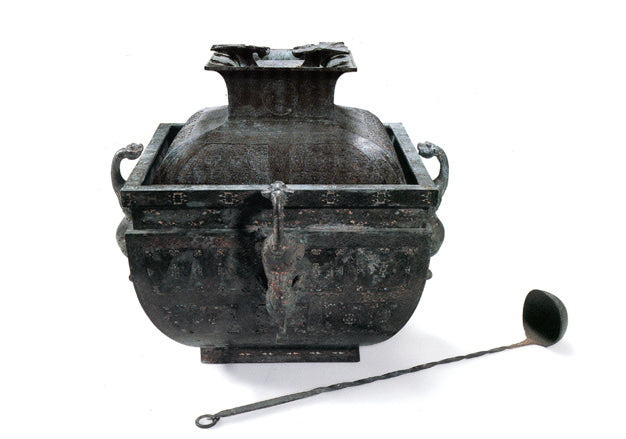
Inlaid Gold, Silver and Copper Square Mirror and Copper Square Lei

Copper square mirror with inlaid gold and turquoise dragon ears and copper square jar (with spoon), bronze wine vessels, Warring States Period. Mirror: 21.6 cm in height, 30.8 cm in length; jar: 32 cm in height, 15.6 cm in length, spoon: 43.7 cm in length. Unearthed in Shangcunling, Sanmenxia City in 1975. Now in the collection of Henan Museum.
From winter 1974 to April 1975, the third production team of Shangcunling Brigade in Sanmenxia City discovered eight ancient tombs during the construction of a reservoir in the west of the ridge, and obtained more than 100 bronzes and more than 50 pottery. This set of bronzes was unearthed in Tomb No. 5.
Copper square mirror with inlaid gold and turquoise dragon ears(Figure 1). The shape of the vessel is in the shape of a bucket, with a square mouth, an inward folded mouth edge, a square lip, a short neck, and a belly wall that is slanted toward the bottom of the vessel, and a square ring foot at the bottom. The rim and neck of the mirror have a composite diamond pattern of inlaid gold and turquoise. The outer wall of the belly of the mirror is divided into square bars with hook-linked patterns, and the bars have square geometric patterns of inlaid gold and turquoise. Four dragon-shaped ears, the body curled up and lying, the head climbing on the mouth of the vessel to explore the water, the head and limbs are cast with geometric shapes and dots, and the dragon body is inlaid with turquoise.

(Figure 1)
Inlaid gold lacquered copper square jar with coiled snake pattern (Figure 2). Wide mouth, flared lip, thin neck, wide shoulders, bulging belly, flat bottom, and square ring foot below. There are circular grooves cast on the four sides of the outer wall of the neck. There should have been inlays, but they are no longer there. The outer wall of the belly of the jar is demarcated by a square grid, and the wide strips between the grids are all inlaid gold geometric patterns. The grid is decorated with fine coiled snake patterns. The lid is also very delicately cast. The top of the lid is a linked geometric pattern. The outer edge of the top is cast with fig leaf-shaped decorations and inlaid gold patterns. There is a layer of black shiny material on its surface, which should be the original lacquer on the surface of the object.
(Figure 2)
There is a copper spoon in the jar. The end of the spoon is round. The middle part of the spoon handle is twisted into a twist shape. There is a hole at the top, which can hold a ring.
The bronze inlay technique is applied to the whole body of the bronze mirror and the bronze jar. Generally, the decorative groove is reserved on the surface of the object, or the decorative groove is engraved after casting. Softer metal wires such as gold, silver, and red copper, or jade, turquoise, lacquer, etc. are embedded respectively, and then inlaid to make the surface smooth. The different materials between the decoration and the object show a mutually radiant effect. The inlay technique has appeared since the Xia Dynasty. Most of them are jade inlaid on bronze objects, such as the bronze plaque with animal face pattern inlaid with turquoise unearthed from the Erlitou site (Figure 3). In the Shang Dynasty, the practice of filling bronze vessels with lacquer appeared again. For example, the bronze tripods unearthed from the Xi State Cemetery in Mangzhang Township, Luoshan County, Xinyang, which were filled with black lacquer. This method of filling lacquer was still used in the artifacts unearthed from the Liuli Pavilion Cemetery in Huixian during the Spring and Autumn Period and the Warring States Period. Since the middle and late Spring and Autumn Period, the craft of inlaying gold, silver or red copper has been used on bronze vessels. It became particularly popular during the Warring States Period. Not only did the objects used become more diverse, but the materials used for inlay and inlay also became more diverse. At the same time, some objects with clever shapes and neat patterns also appeared. The bronze mirror unearthed from Shangcunling uses gold wire coils to fill the gaps. The gold wire coils are neatly inlaid, and the surface of the object is polished and smooth, which is enough to represent the new achievements of the gold inlay craft in the Warring States Period. The bright black lacquer on the body of the bronze jar not only increases the contrast of the patterns and colors, making it more ornamental, but also has the function of preventing rust.
Although this set of bronze jars and mirrors have gone through the vicissitudes of time and their surfaces are covered with rust, we can still imagine their refinement and luxury through the mostly well-preserved patterns.



![8.3"China Shang Dynasty,Bronze wine cup [Fuhao Jue cup][妇好爵杯]](http://bronzc.com/cdn/shop/files/4ee0482982cfa89bb4d1cff3333a55e6_e3ca0b86-22fc-497d-9afd-578c551225a3-2.jpg?v=1733986652&width=533)

![12.8" China Ming Dynasty, Phoenix-patterned bronze vase[Ming Wanli Phoenix-patterned vase][明万历凤纹瓶]](http://bronzc.com/cdn/shop/files/4ee0482982cfa89bb4d1cff3333a55e6_a516991b-2bb9-4b2f-a2b6-4354129d006c.jpg?v=1733986953&width=533)

![14.6" China Eastern Han Dynasty Bronze vessel in the shape of a flying horse,Also known as bronze galloping horse[Horse Stepping on Flying Swallow][马踏飞燕]](http://bronzc.com/cdn/shop/files/4ee0482982cfa89bb4d1cff3333a55e6_aa3fbeb8-e08b-4a44-929a-13411ca8fb17-2.jpg?v=1733987211&width=533)

![5.9"China Tang Dynasty, Bronze of a walking dragon[Tang Walking Dragon][唐走龙]](http://bronzc.com/cdn/shop/files/2_8cb416b9-ebbd-4fe2-a905-b9277f820c16.png?v=1731488701&width=533)
